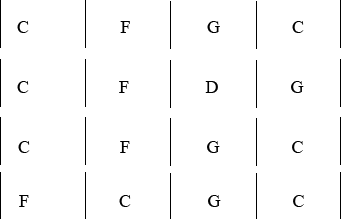
[Overview] [Ragtime Form] [Syllabus]
The general ragtime form is sixteen measures long and consists of four, four measure phrases. The diagram shown below represents one commonly used ragtime form.

Blank measures can be filled in randomly with your choice of I, IV, or V chords.
Note the following:
The V/V chord is the "five of five" chord. Ask yourself this question: If I switch to the key of the V chord, what is the V chord in that key?"
For example: in the key of C, the V chord is G. In the key of G, the V chord is D. Therefore, the V/V chord in the key of C is the D chord.
The V7 chord is the V chord with another third added on top, forming the structure root, third, fifth, seventh.

The structure of the V7 chord can be thought of as:
The V chord and the V7 chord are interchangeable.
Here are some possible forms created by filling in the blank measures.
The chords I chose for the first line are I IV V I.

These are chords notated as root position triads in the bass clef.

A typical Scott Joplin ragtime composition usually consists of four, sixteen measure sections.
![]()
In the full ragtime form, the A and B sections are in the key of the I chord. The C and D sections are often in the key of the IV chord. For example if the A and B sections are in the key of C, then the C and D sections will be in the key of F.
We'll just be working on the A section.
Next Previous
[Overview] [Ragtime Form] [Syllabus]
Revised by John Ellinger, Spring 2012.